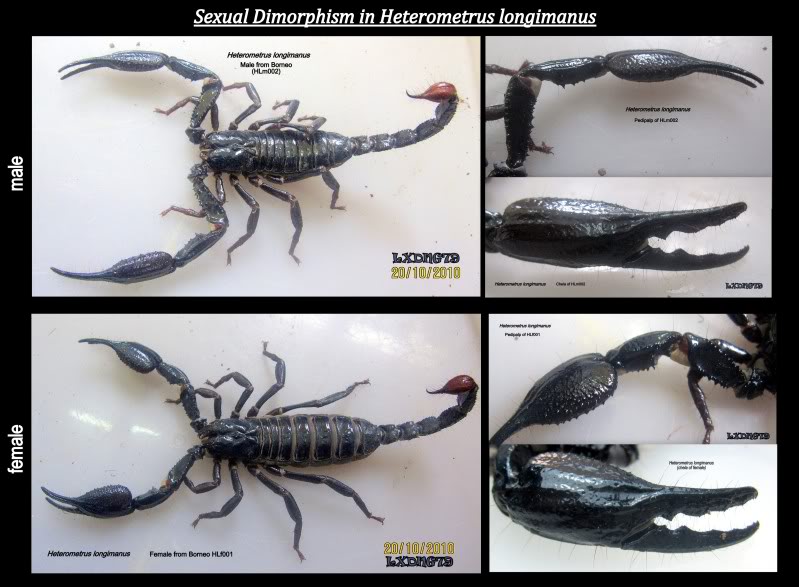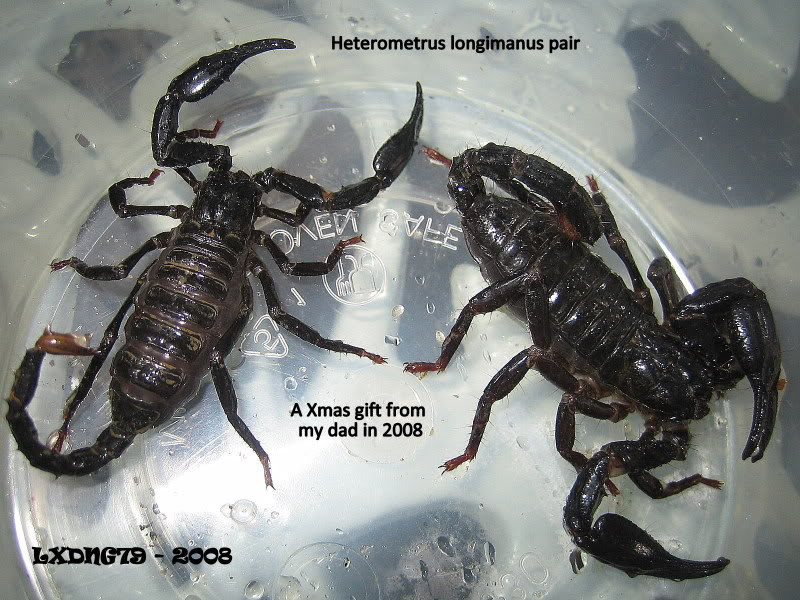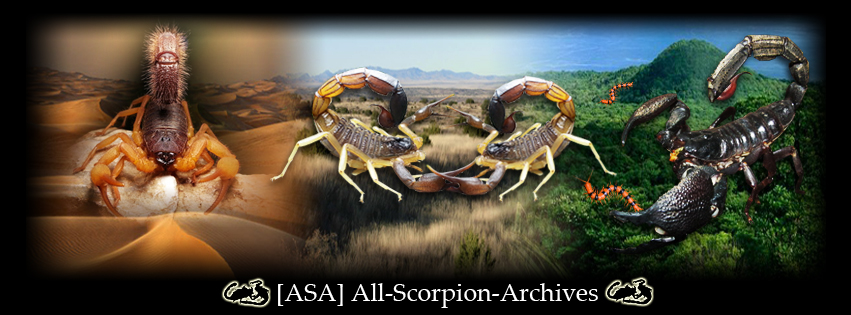Heterometrus longimanus
Page 1 of 1
 Heterometrus longimanus
Heterometrus longimanus

INTRODUCTION
One of the world’s larger tropical Scorpionids, Heterometrus longimanus constitutes the predominant representative of the family Scorpionidae in Borneo, Java, Sumatra, Bali Indonesia, right up to the Philippines. They are known to occur in Singapore, but are absent from the Malaysian Peninsular (Kovarik 2004). A large portion of taxonomical literature on Heterometrus species from South East Asia, have designated many varieties under the species nomenclature of longimanus. Before Kovarik’s 2004 revision, the ambiguity of Heterometrus speciation has been largely understated by many mainstream nature publications which erroneously identified numerous specimens of Heterometrus. Adding to this confusion were the indistinguishable similarities among females and juveniles of several species found in the South East Asia; H. longimanus along with H. liophysa, H. spinifer and H. cimrmani; were only reliably indentified through gender dimorphism in the males (Kovarik 2004). The striking sexual dimorphism in H. longimanus; so starkly distinguishes it from the female, that many could have placed them as different species altogether.
Sexual Dimorphism in H. longimanus
Close examination of the pedipalpal segments exhibit substantial proportional differences between male and female specimens. In males, the femur and patella clearly more elongated than that of the female. Lateral depiction of the chela illustrates how the manus of the female is noticeably more slender and elongated than that of the female. Consequentially ventral inspection of the operculum is not needed for the sexing of this species. Sexual dimorphism only appears at maturity. Determining gender among juveniles and sub-adults is rather unreliable.


Natural Habitat H. longimanus inhabit the humid tropical rainforest of South East Asia. Essentially fosorial, many observations by hobbyist and enthusiasts claim that they exhibit behaviours which seem to suggest a semi-arboreal lifestyle. The numerous occasions that I have found H. longimanus suggest that their arboreal tendencies may simply be circumstantial adaptation to different situations. Across their distributive range H. longimanus occur in both lowland and highland areas. In remote pristine jungles they frequently reside in dugouts of extensively emaciated tree trunks, or burrows at the base of standing tree roots; not dissimilar to those of H. spinifer. In seasonally flooded lowlands or riverside areas, they can be found inhabiting trunks trees higher off the ground. Some burrows I’ve seen were situated at the base of the tree oriented vertically up against the tree trunk. Others I’ve found occupying tree crevices several meters off the ground. One specimen in particular was found inhabiting a vertical cleft in the trunk of a tree that stood at the waters’ edge of a small river in a forest.

This adaptability is one reason why this species is seen to persist in areas considerably affected by human impact. In Western Borneo it is not uncommon to find them in small isolated pockets of designated greenery right in the heart of Kuching‘s urban city. Some have been found etching out a living at the base large trees of not far from traffic-congested roadsides. Despite the amount of human disturbance and pollution, these trees hosts a vibrant community of other invertebrates, from crickets, burrowing roaches, woodlice, millipedes, hunting spiders and even scorpions of a different cast - Liocheles australasiae; providing refuge for both these scorpions and their prey. Simultaneously, urban environments and the human waste it generates, sustains an adhering population of cockroaches which also provides them ample food.
Temperament and Behaviour Due to their size, this species can certainly make itself seem intimidating when annoyed. Once fully-grown, they have few natural enemies. They mostly reside at the entrance to their burrows into which they quickly retreat once any threat is detected. Occasionally some are found wandering into human dwellings when their usual hiding places have been flooded by torrential downpour. They have a habit of raising their large pedipalps and ‘clapping’ them together loudly as a defensive strategy. In truth, they are mildly-tempered creatures when they do not feel harassed and can be managed rather easily when not roughly handled.
Toxicity: Though the venom of this species comprises of numerous molecular components that target a wide array of chemical processes that result in different symptomatic affects, its low concentration and mildness renders stings from this species non-lethal and medically unimportant. Nonetheless, the venom of this species has been thoroughly analysed for novel peptides (Bringans et. al, 2007). My personal account of being envenomated by this species could be described as an acute moderate burning sensation which persists for roughly 20 minutes, preceded by slight numbness of the area which eventually dissipates within two hours. On rare occasions, the surrounding tissue may be slightly inflamed or reddish. Envenomations by younger individuals are considerably more painful than those inflicted by adult specimens. By comparison, I would have to say that the sting of H. longimanus is substantially more intense than that of H. spinifer, and is comparably close but still more painful than that of Pandinus imperator.
THE KEEPING & BREEDING OF H. longimanus
Housing requirements for this species is the same for most large tropical Scorpionids such as P. imperator or Heterometrus sp. Floor space is more important than height. A small 1x½ x½ft aquarium should be ideal for a single adult specimen, compact enough to ensure that any prey item given is caught and consumed immediately. The hide should be heavy enough to prevent the scorpion from upturning it, and the water bowl wide and deep enough for them to partially immerse themselves in. The substrate should be 2 to 3 inches deep and as long as the lid is secure, it is not required for the top of the aquarium to be higher than the scorpion can reach. Ideal temperature range is 22 – 28°c (71.6 – 82.4°F) and the humidity should be kept relatively high. The substrate should remain cool and slightly moist but not too damp. For hydrating the enclosure, pouring water directly on to the substrate is more effective than misting alone. When kept in ideal conditions, they are unlikely to leave the comfort and security of their burrows, unless they are adult males in search of mates.

Communality of this species is typical of most Heterometrus. Juveniles and adolescents are very communal and can be kept together in large numbers without problems. Large breeding-size adults can be aggressively territorial; females more so than males. Keeping large adults communally would require a terrarium large enough for each scorpion to occupy its own den space. It is generally better to introduce all individuals into a communal setting simultaneously, rather than allowing one or two to initially claim territories which they may aggressively defend against subsequently introduced individuals. While most will get along fine in a communal setting, some simply can’t be kept with others. Thus, it is advisable to assess the personal temperaments of certain individuals before choosing to introduce them into a communal mix. Gravid or brooding females are easily agitated and should be isolated to minimize stress. My communal setup is a 2x1x1ft glass terrarium with 3 – 4 inches of substrate and several overlapping layers of tree bark under a large piece of driftwood to provide ample hiding places. A terrarium this size should accommodate up to 5 large adult individuals (originally intended for 6, which ended up being one female too many).
Feeding: Their considerable size allows these formidable predators to overpower a wide range of invertebrates and small animals. Though roaches are more appropriate for scorpions of this size, 2 to 3 large crickets may be given for each scorpion as a staple between intervals of 1 or 2 weeks. The larger the prey item, the longer the interval between feedings. They will also take wax-worms (Super Worms), but these should be chucked in front of a waiting scorpion, to avoid the worms from burrowing into the substrate.
Breeding: Embryonic development in Scorpionids is categorized as Katoikogenic; meaning the absence of yolk and the embryos are nourished by mother in a similar manner to mammals (Polis, 1990). Gestation period for this species is roughly 10 months to a year. It is not certain if they breeding during a particular season but 4 of the 6 mature females I collected from the wild gave birth to broods within the same time frame between mid April and mid May. Adequate moisture and humidity seems to be a factor in encouraging parturition. On two occasions, two females that have already produced young in captivity gave birth again after almost a year kept in isolation; indicating that they are capable of producing systemic broods i.e. multiple broods from one mating.
Growth & Development: Raising Heterometrus is a rewardingly simple task since the females take exceptional care of their young. Like other Heterometrus species, the young are born as white glutinous soft-bodied larvae, clinging to the mother’s dorsum. After their first moult they become miniature light-coloured replicas of the adults. After they leave her back, the mother maintains her role as protector but provides for her young by subduing large prey items which she often eviscerates into bite-sized portions for her young to consume in a mass feeding ball. Their colours begin to darken after the 3rd ecdysis. At this stage they are at their most communal. Occasionally one will be eaten from coming out of a bad moult, but other than this, cannibalism is a rare occurrence.


From my experience, it is not at all necessary to separate the young after the 2nd or 3rd moult. In fact, scorplings that are kept with the mother tend to develop faster and more robust than those separated at an earlier stage. Scorpions that are raised together in captivity often remain communal. I’ve even managed to keep some broods together with the mother until maturity without problems. As captive-kept communities grow, larger enclosures should be prepared to accommodate them. They undergo a total of 6 (sometimes 7) ecdysis before reaching the adult form. In captivity, they take roughly 1 year to mature. Their adult lifespan is difficult to determine but they are known to live for about 10 years or more.
Advanced Sub-Social Behaviour among primitive arthropods like scorpions is rare and largely associated with maternal care. In the wild, it is probable that H. lonigmanus mothers may eventually leave the nest burrow where their young will remain to living together like a sub-social colony; hunting and consuming prey cooperatively as juveniles and sub-adults. This is consistent with many accounts of large numbers of scorpions found living together in backyard compost heaps. This advanced level of sub-social behaviour among large tropical Scorpionids is relatively common and has been observed and documented in the wild in other species of the genus Heterometrus i.e. H. fluvipes (TShivashankar 1994) and H. spinifer; (Krapf, 1986 cited in TShivashankar 1994). Little is known regarding why and how these scorpions disperse or congregate, though it is apparent that while females and their young may occupy a den site for long periods of time, adult males seem to be more transient in their wanderings.

In many instances, H. spinifer and H. longimanus have been mistaken for each other even by experienced naturalist. In the hobby trade, they are more often sold under the generic description of ‘Asian Forest Scorpion’ through suppliers who are usually indiscriminate about the origins of the specimens they provide to retailers. This complicates the task of accurately identifying the species of any given specimen which is crucial for determining compatible breeding pairs. Both species are somewhat similar in size and coloration, though H. spinifer are generally larger and more heavily built than H. longimanus and adult male H. spinifer lack the gender dimorphism present in H. longimanus males. The females of the two species look very much alike and are difficult to differentiate. Kovarik’s (2004) diagnostic of both species stated that the manus of H. longimanus being sparsely tuberculate whereas those of H. spinifer having smooth carinae that formed irregular reticulations.

Couzijn (1981) proposed granulations of the prosoma (carapace) as a valid key in speciation and sub-speciation within the genus Heterometrus and proposed 10 subspecies for H. longimanus. These nominal subspecies were synonymised by Kovarik’s (2004) review of the genus except for H. longimanus liophysa, which elevated to its own species. Kovarik (2004) considered this character to be unreliable in Heterometrus speciation as it varied greatly within definite species across disparate regional populations; making identifying them based on this aspect very problematic.

According to Kovarik (2004) the prosoma of both species had smooth discs with margins granulate, with one difference being H. longimanus sometimes had the entire surface granulated. When compared to one another, the prosoma of H. longimanus is generally more finely granulated than that of H. spinifer; the later having more pronounced granules that are also fewer in numbers. In some specimens of H. longimanus, the margins that define the lateral discs of the prosoma tend to be more angular. These demarcations tend to be more smoothly rounded in H. spinifer.
Conclusion
This species has been described in some of the oldest literature on Scorpions. Throughout their distributive range, H. longimanus along with its other close relatives represents the archetypal image of what a scorpion is in the eyes of most local people. In Borneo, the symbol of the scorpion, known as kala is potently expressed in the tattoo culture of many indigenous tribes such as the Iban. Yet for all its enduring presence in human culture, a significant amount is still unknown about the animal itself. Though it is one of the more studied species of scorpions, many apparent questions about their natural history remain unanswered.

Some of them questions I have are: What were the forces of natural selection that shaped this extent of sexual dimorphism we see in H. longimanus? Is it correlated with their courtship behaviour; through female preference or sexual competition? Why did this occur in some species of Heterometrus and not in others throughout their adaptive radiation? Can this be linked to survival adaptation in specific environmental conditions or an advantageous aspect in prey capture? How do territorial boundaries determine their dispersion throughout an area, and what can the subtle extents of their sub-social behaviour inform us about the formation of social-structures among insects and other animals? What ecological roles do they fulfil and what significance does it play in the lives of other species that share its habitat?

As my first scorpion species, I’ll always remember it as my introduction to their fascinating world. At the age of 9, I found a large adult female two houses away from my home, and for the first time, the scorpion was no longer a static photograph or still-illustration in a book, but a living creature whose behaviour and movements intrigued me from how it consumed its prey to all other aspects of its life. In a time with no internet, what little was written about scorpions in books and encyclopaedias could not even tell its species name. When other sources seemed to care little about them or the fact that little was known about them, this urged me to seek them out in pockets of forest around my hometown and learn all I can about them. Because of this particular species, I have developed a life-long interest and fervent enthusiasm for biodiversity and the natural world. My thanks to you - Heterometrus longimanus

References
1. Bringans, S.; Eriksen, S., Kendrick, T.; Kaur, R.; Gopalkrishnakone P. and Lipscombe R. 2007 “Proteomic analysis of the venom of Heterometrus longimanus (Asian black scorpion)” Proteomics International, PO Box 6064, East Perth, WA 6892, Australia; 2Venom and Toxin Research Programme, Yong Loo Lin School of Medicine, National University of Singapore, Singapore.
2. Couzijn, H. W. C. 1981 “Revision of the genus Heterometrus Hemprich & Ehrenberg (Scorpionidae, Arachnida )” Zoologische Verhandelingen 184.
3. Kovarik, F. 2004 “Ehrenberg, 1828, with Descriptions of Seven New Species (Scorpiones, Scorpionidae)” Euscorpius Publications
4. Polis, G. A. 1990 “The Biology of Scorpions” Standford University Press
5. TShivashankar 1994 “Advanced Sub-Social Behavior in Heterometrus fluvipes” J. Biosci•, Vol• 19, Number 1, March 1994, pp 81-90• © Printed in India•

LXDNG79- Scorpion researcher
- Posts : 15
Join date : 2013-02-14
Age : 44
Location : Kuching, Sarawak, Borneo, Malaysia
 Similar topics
Similar topics» Heterometrus longimanus
» Not sure if longimanus or the other heterometrus
» My Heterometrus Longimanus Lair
» [FS] Heterometrus longimanus (Indonesia)
» H. longimanus
» Not sure if longimanus or the other heterometrus
» My Heterometrus Longimanus Lair
» [FS] Heterometrus longimanus (Indonesia)
» H. longimanus
Page 1 of 1
Permissions in this forum:
You cannot reply to topics in this forum|
|
|
